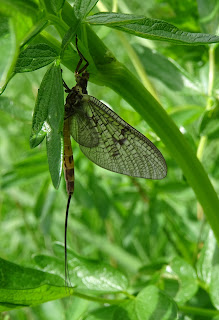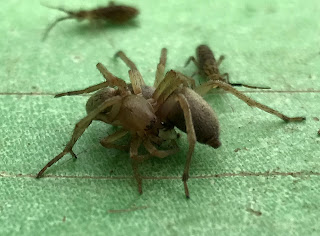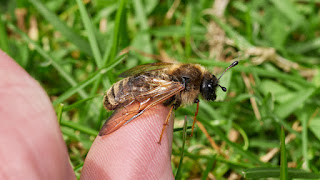Wednesday 25th May 2022, Ruewood Shropshire Wildlife Trust Reserve
 |
| Photograph: Jim Cresswell |
“Whose eyes?”, you may ask,
Read on. All will be revealed.
Due to the very limited parking at the site we met in the car park of the Tilley Raven.
Always looking for opportunities, especially in the vegetation around a car park, a quick beat of some ivy provided us with a small “inconspicuous” ladybird, Nephus quadrimaculatus.
 |
| Photograph: David Williams |
An advance party strode out for the site along a footpath whilst the rest of us arranged ourselves into three cars and drove to the entrance of the site.
Having arranged the cars so that no road or field entrance was obstructed, we made our way along an extremely well but rampant vegetated track to the stile and gate that lead into the first of the two meadows that make up this reserve.
We were soon into our stride and, rather like our visit to Pentre Hodre Farm the previous week, one of our earliest finds was the longhorn beetle Anaglyptus mysticus.
 |
| Photograph: David Williams |
About halfway long the southern edge of the meadow there was a very wet patch where Yellow iris grew.
 |
| Photograph: Bob Kemp |
In turn this attracted insects of interest of which Rhingia campestris was one.
 |
| Photograph: David Williams |
A small aircraft passed overhead.
Followed a few minutes later by a second, and possibly a third.
This pattern continued throughout a lot of the day, reminding us that the reserve was very close to Sleap airfield. It is likely that we were under the looping flight path of pilots practising take offs and landings.
A Beautiful demoiselle was spotted;
 |
| Photograph: Bob Kemp |
Together with a cranefly, Tipula vernalis;
 |
| Photograph: Jim Cresswell |
And another hoverfly, this time the bee mimic, Volucella bombylans.
 |
| Photograph: Bob Kemp |
It is a known as a bee-mimic as its hairiness and colour pattern is very similar to the Garden bumble bee, Bombus hortorum.
Alder is a very common tree around the edge of the reserve and beating this revealed a pair of 10-spot ladybirds trying to produce the next generation. However, they were different forms, the male being f. decempustulatus, with the large red patches on a dark background, and the female f. decempunctatus with the smaller black spots on a red background. I have no idea which form their progeny will take.
 |
| Photograph: David Williams |
As I was wandering about I passed (thankfully did not stand in) a fresh cow pat. Enjoying this by-product were a few flies including a Noon-day fly, Membrina meridiana. Unfortunately by the time I had retrieved my camera it had hidden underneath the edge frustrating my efforts. However another example of this fly was photographed some time during the day.
 |
| Photograph: Jim Cresswell |
A fly that we found throughout the day was the down-looker fly, Rhagio scolopaceous. It is deserving of its common name as when it settles on, say, the trunk of a tree, it takes up a position with its head downwards.
 |
| Photograph: Bob Kemp |
I am not sure where the next insect was found but now is as good a time to include it as any. A sawfly, Tenthredo mesomela.
 |
| Photograph: John Martin |
Interspersed with the alders around the site boundaries were various willows including Sallow. It was a sallow that provided us with the smallest insect of the day, at just over 1mm in length, that we were able to identify, another “inconspicuous” ladybird, Stethorus pusillus.
 |
| Photograph: David Williams |
This has become known as the Dot ladybird. This is another deserved common name as its size and shape resemble a dot with legs!
Moving towards the north-western corner of the site along the fenced hedgerow that separated the two meadows we came across the plant that lends its name to the site, Common meadow-rue.
Hiding under its leaves we found a may-fly, which may be Ephemera danica.
The small umbellifer Pignut was plentiful and this was a the species of plant on which the hoverfly Parhelophilus, possibly frutetorum, chose to settle.
 |
| Photograph: Jim Cresswell |
(Thank you to everyone who has pointed out that my identification of this insect as Helophilus pendulus was incorrect.)
It was also a feeding opportunity for a Small copper butterfly.
 |
| Photograph: John Martin |
After all this excitement we needed a sit-down and lunch was called.
 |
| Photograph: Neil Nash |
Do not worry, I have not forgotten about the "Eyes".
After lunch we dispersed a little with some going through to the second meadow and others staying a little longer in the first. It was from an Apple tree in the first meadow that this longhorn beetle, Tretops praeustus was extracted. It is known as the Plum longhorn.
 |
| Photograph: David Williams |
This find inspired the finder to look in the apple trees in his garden when he got home, and, as if by magic, he found another example of the beetle in residence. If you have an apple or plum tree in you garden, why not give it a go?
The rest of us moved into Meadow 2.
And now for the "Eyes" …
They are extraordinary.
They belonged to this insect.
 |
| Photograph: John Martin |
This is Hybomitra bimaculata. It is a member of the Tabanidae, which are known as Horseflies or Clegs. Many if not all have patterned eyes of varying complexity.
The females of many of the species require a “blood meal” after mating and before egg-laying. Usually this meal is taken from domestic stock but, as we all know, humans are often targeted. Unfortunately for us they are very silent in flight and can land undetected. The first time we notice their presence is when an attempt to draw blood is made. Apparently Hybomitra bimaculata’s favourite feeding spot is the “crutch of the legs”.
The meadows contained a number of orchids in flower including this Southern marsh orchid in the second meadow.
 |
| Photograph: Bob Kemp |
The afternoon was wearing on and some decided to take a break …
Whilst some had a sit down to watch the world go by and listen to the sounds of nature …
Only to be interrupted by aircraft still flying over trying to land …
Others carried on. What stamina they have.
A Wasp beetle was found;
 |
| Photograph: David Williams |
Followed by a couple of large click beetles:
Ctenicera pectinicornis;
 |
| Photograph: Neil Nash |
Actenicerus sjaelandicus.
 |
| Photograph: Bob Kemp |
The second meadow was larger than it looked and getting around it took quite a long time. Many of the invertebrates we found had been seen earlier but we were able to find a couple of moth larvae:
A Drinker;
 |
| Photograph: Neil Nash |
And a Common quaker.
.JPG) |
| Photograph: Stephen Mitchell |
Exhausted after another long day on an excellent site we made our way back to the entrance of the site.
On the way this beetle was spotted.
 |
| Photograph: Bob Kemp |
I do not know the species and help has been sought to identify it. If it can be identified from this photograph I will update the report to provide the name.
We extracted ourselves and cars from the site, closed the gate behind us and made our way back to the Tilley Raven from where, after a quick round of refreshments, we made our way home.
Have I forgotten the Wednesday Weevil of the Week?
No …
Here it is.
Well, it may be Dorytomus taeniatus or it could be Dorytomus dejeani; they impossible to tell apart.
.JPG) |
| Photograph/; Emm Cane-Honeysett |
My thanks to Shropshire Wildlife Trust for giving us permission to do what we enjoy doing and to the photographers for their excellent images.
Special thanks to the Tilley Raven for allowing us to use their car park.
.JPG)







.jpg)


.jpg)








.jpg)








.jpg)






























